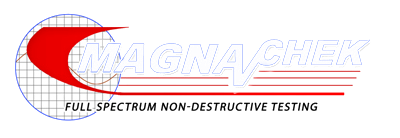Dye Penetrant Inspection is a means of locating fine cracks on the surface of parts by allowing a visible or fluorescent dye to accumulate in any such discontinuity to reveal its shape and location. The technique is applicable to virtually any non-porous material.
Dye Penetrant Inspection is a three-step process beginning with the application of a visible or fluorescent dye to the clean, dry surface of the test specimen. In a short time the penetrant is drawn into any surface depressions or voids by capillary action. After a pre-determined interval the excess penetrant is removed and a developing agent is applied to the surface. The developing agent draws the remaining penetrant out of the cracks to make them readily visible to an inspector. This technique can be used to detect surface flaws on essentially any non-porous material.
Experience counts
A number of factors will affect the Dye Penetrant Inspection process including the material, the type of defect to be found, and the surface condition of the parts before testing. All of these factors must be considered when determining surface preparation requirements, which penetrants and developers to use, and processing times. Magna Chek’s experienced personnel can tailor the inspection process to meet your exact needs.
Ideal for on-site inspections
High-volume dye penetrant inspection operations for castings, forgings and many other parts are common because of its simplicity and relative low cost. The technology, however, is easily implemented in remote locations to check the integrity of welds in fabricated structures or for locating stress cracks on aircraft.
Acceptable Standards
ASTM E165-09 Standard Practice for Liquid Penetrant Examination
ASTM E1220-10 Standard Practice for Visible Penetrant Testing Using Solvent Removable Process
ASTM E1209-10 Standard Practice for Fluorescent Liquid Penetrant Testing Using the Water Washable Process
ASTM E1210-10 Standard Practice for Fluorescent Liquid Penetrant Testing Using the Hydrophilic Post Emulsification Process
Limitations
Surface preparation, including de-greasing, is necessary
Some penetrants are difficult to remove
Spurious indications are possible from surface blemishes
Special equipment is required for fluorescent penetrant inspection
Precautions must be taken with respect to handling penetrant chemicals
Precautions should also be taken with ultraviolet light (UV) to avoid excessive exposure
Advantages
Relatively simple to use
High sensitivity
Wide range of materials (any nonporous material can be inspected)
No special apparatus required
Ideal for examining large areas


